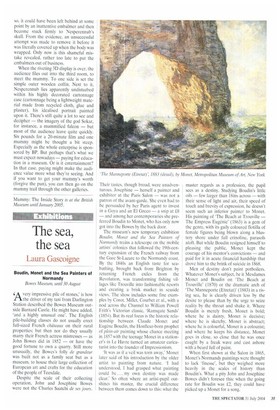The sea, the sea
Laura Gascoigne
Boudin, Monet and the Sea Painters of Normandy Bowes Museum, until 30 August
c A very impressive pile of stones,' is how
the driver of my taxi from Darlington Station described the Bowes Museum outside Barnard Castle. He might have added, 'and a highly unusual one'. The English pile-building classes do not usually erect full-sized French cheiteaux on their rural properties; but then nor do they usually marry their French actress mistresses — as John Bowes did in 1852 — or have the good fortune to own a quarry. Still more unusually, the Bowes's folly de grandeur was built not as a family seat but as a museum, to house their large collection of European art and crafts for the education of the people of Teesdale.
Despite the scale of their collecting operation, John and Josephine Bowes were not the Charles Saatchi de ses fours. Their tastes, though broad, were unadventurous. Josephine — herself a painter and exhibitor at the Paris Salon — was not a patron of the avant-garde. She even had to be persuaded by her Paris agent to invest in a Goya and an El Greco — a snip at .f8 — and among her contemporaries she preferred Boudin to Monet, who has only now got into the Bowes by the back door.
The museum's new temporary exhibition Boudin, Monet and the Sea Painters of Normandy trains a telescope on the mobile artists' colonies that followed the 19th-century expansion of the French railway from the Gare St-Lazare to the Normandy coast. By the 1840s an English taste for seabathing, brought back from Brighton by returning French exiles from the Revolution, was transforming fishing villages like Trouville into fashionable resorts and creating a brisk market in seaside views. The show includes some fine examples by Corot, Millet, Courbet et al., with a nod across the Channel to William Powell Frith's Victorian classic, `Ramsgate Sands' (1854). But its real focus is the historic relationship between Claude Monet and Eugene Boudin, the Honfleur-born prophet of plein-air painting whose chance meeting in 1857 with the teenage Monet in a stationer's in Le Havre turned an amateur caricaturist into the founder of Impressionism.
'It was as if a veil was torn away,' Monet later said of his introduction by the older artist to painting from nature. 'I had understood. I had grasped what painting could be ... my own destiny was made clear.' So often where an artist-pupil outshines his master, the crucial difference between them comes down to this: what the master regards as a profession, the pupil sees as a destiny. Studying Boudin's little oils — few larger than 18ins across — with their sense of light and air, their speed of touch and brevity of expression, he doesn't seem such an inferior painter to Monet. His painting of 'The Beach at Trouville — The Empress Eug8nie' (1863) is a gem of the genre, with its gaily coloured flotilla of female figures being blown along a blustery shore under full crinoline, parasols aloft. But while Boudin resigned himself to pleasing the public. Monet kept the courage of his mentor's convictions — and paid for it in acute financial hardship that drove him to the brink of suicide in 1868.
Men of destiny don't paint potboilers. Whatever Monet's subject, be it Mesdames Monet and Boudin on 'The Beach at Trouville' (1870) or the dramatic arch of `The Manneporte (Etretat)' (1883) in a rising sea, he is clearly driven less by the desire to please than by the urge to seize reality by the throat and shake it. Where Boudin is merely fresh, Monet is bold; where he is dainty, Monet is decisive; where he is sketchy, Monet is abstract; where he is colourful, Monet is a colourist; and where he keeps his distance, Monet goes in close, so close that he was once caught by a freak wave and cast ashore with a beard full of paint.
When first shown at the Salon in 1865, Monet's Normandy paintings were thought to lack 'finesse', but they weighed more heavily in the scales of history than Boudin's. What a pity John and Josephine Bowes didn't foresee this: when the going rate for Boudin was £2, they could have picked up a Monet for a song.


























































 Previous page
Previous page